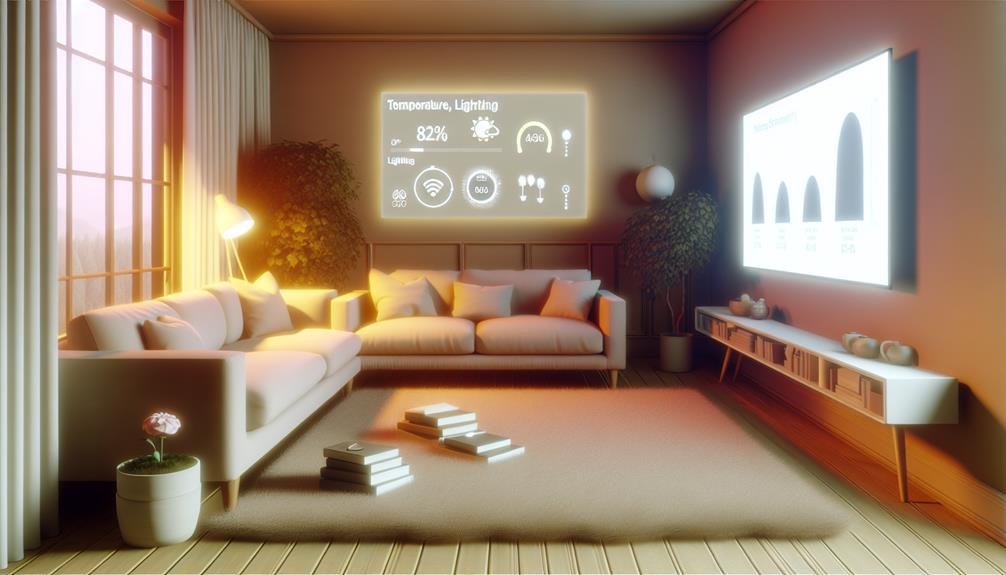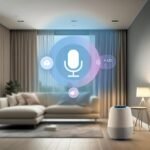Imagine your home as a well-oiled machine, where every component works seamlessly together to ensure your comfort, security, and convenience.
Just like a conductor orchestrating a symphony, remote monitoring and control in smart home automation allows you to take charge of your living space, effortlessly navigating through the different aspects of your daily life.
But what exactly are the benefits? How can this technology enhance your home experience and make your life easier?
Stay tuned to uncover the answers and unlock the potential that smart home automation has to offer.
Key Takeaways
- Enhanced security and safety: Remote monitoring and control of security systems, smart locks, and surveillance cameras provide constant home protection and immediate responses to potential dangers.
- Energy efficiency and cost savings: Integration of smart appliances, thermostats, lighting systems, and power outlets optimize resource usage, leading to potential cost savings on heating, cooling, lighting, and standby power consumption.
- Convenience and flexibility: Control of smart home devices from anywhere, personalized schedules, integration with voice assistants, and customizable settings offer increased comfort and convenience without manual effort.
- Remote monitoring for peace of mind: Monitoring of vital signs, medication schedules, security systems, cameras, and alarms remotely allows for immediate action to protect loved ones, valuable possessions, and assets in case of emergencies or breaches.
Enhanced Home Security
Enhance the security of your home with smart home automation, allowing you to remotely monitor and control various aspects of your security system. With smart locks and surveillance cameras, you can have peace of mind knowing that you have advanced security measures in place.
Smart locks are a key component of a smart home security system. These locks allow you to remotely lock or unlock your doors, giving you control over who's access to your home. Forgot to lock the door when you left? No problem. Simply use your smartphone to lock it remotely. Have a trusted friend or family member coming over? You can grant them temporary access and receive notifications when they arrive and leave.
Surveillance cameras are another essential feature of a smart home security system. These cameras can be strategically placed around your home to provide you with a comprehensive view of your property. You can access the live feed from these cameras using your smartphone or computer, allowing you to monitor your home from anywhere, at any time. In case of any suspicious activity, you can quickly take action, such as alerting the authorities or activating an alarm system.
Energy Efficiency and Cost Savings
To optimize your home's energy usage and save on costs, smart home automation offers a range of energy-efficient features and monitoring capabilities. By integrating smart appliances and utilizing real-time data, you can significantly reduce your energy consumption and enjoy substantial cost savings.
Smart appliances, such as smart thermostats, smart lighting systems, and smart power outlets, play a crucial role in improving energy efficiency. These devices can be programmed to automatically adjust settings based on your preferences, occupancy patterns, and weather conditions. For example, a smart thermostat can learn your daily routine and adjust the temperature accordingly, ensuring that energy is not wasted when you're away from home.
Real-time data monitoring is another key aspect of energy efficiency in smart homes. With the help of sensors and smart meters, you can track your energy usage in real-time and identify areas where you can make improvements. This data can be accessed through a centralized smart home control panel or mobile app, giving you the freedom to monitor and control your energy consumption from anywhere.
To illustrate the potential energy and cost savings of smart home automation, consider the following table:
| Smart Appliance | Energy Saving Feature | Cost Savings |
|---|---|---|
| Smart Thermostat | Temperature scheduling and occupancy sensing | Up to 20% on heating and cooling bills |
| Smart Lighting | Motion detection and dimming capabilities | Up to 30% on lighting expenses |
| Smart Power Outlets | Power usage monitoring and scheduling | Up to 15% on standby power consumption |
Convenience and Flexibility
Experience the convenience and flexibility of smart home automation with remote monitoring and control capabilities. With remote access to your smart devices, you can enjoy the following benefits:
- Control from anywhere: Imagine being able to control your home's lighting, thermostat, and security system from the palm of your hand, no matter where you are. With remote access, you have the freedom to adjust settings and monitor your home even when you're away. Whether you're at work, on vacation, or simply lounging on the couch, you have complete control over your smart home.
- Personalized schedules: Smart home automation allows you to create personalized schedules for your devices. You can set your lights to turn on at a specific time, your thermostat to adjust the temperature before you arrive home, and your security system to arm itself when you leave. This level of customization ensures that your home is always comfortable and secure, without any manual effort on your part.
- Integration with voice assistants: Many smart devices are compatible with popular voice assistants like Amazon Alexa or Google Assistant. This means you can control your home automation system using simple voice commands. Whether you're cooking in the kitchen or getting ready in the morning, you can simply ask your voice assistant to turn off the lights or adjust the temperature.
With remote monitoring and control capabilities, smart home automation offers a level of convenience and flexibility that enhances your freedom and simplifies your life.
Remote Monitoring for Peace of Mind
Take your peace of mind to the next level with the remote monitoring capabilities of smart home automation. In today's fast-paced world, it's crucial to prioritize your health and wellness, as well as protect your valuable assets.
Remote monitoring for health and wellness allows you to keep a close eye on your loved ones, even when you're not physically present. With smart home automation, you can monitor vital signs, track medication schedules, and receive alerts in case of emergencies. This technology provides assurance and enables you to take immediate action if necessary.
Furthermore, remote monitoring for asset protection allows you to safeguard your valuable possessions from anywhere in the world. Whether it's your home, car, or other valuable assets, smart home automation allows you to remotely monitor and control security systems, cameras, and alarms. You can receive real-time notifications in the event of unusual activities or breaches, enabling you to take immediate action to protect your assets.
With the freedom provided by remote monitoring, you can have peace of mind knowing that you have full control and visibility over your health and wellness, as well as the protection of your assets. Embrace the power of smart home automation and experience the tranquility that comes with remote monitoring.
Integration and Automation for Seamless Living
With seamless integration and automation, smart home technology enhances your living experience by seamlessly connecting and controlling various devices and systems within your home. Imagine waking up in the morning and as you step out of your bedroom, the lights gradually brighten up, the blinds open to let the sunlight in, and your favorite playlist starts playing in the background.
Here are three ways in which seamless integration and automation can transform your home into a smart living space:
- Connected Devices: Through seamless integration, your smart home devices, such as thermostats, security cameras, and voice assistants, can communicate with each other. This means that you can set up routines and triggers that activate multiple devices simultaneously. For example, when you say 'Goodnight' to your voice assistant, it can turn off the lights, lock the doors, and set the alarm, all with a single command.
- Energy Efficiency: Automated living allows your smart home to optimize energy usage. By integrating your lighting, HVAC, and appliances, you can create schedules and rules that automatically adjust settings based on occupancy and time of day. This ensures that lights aren't left on unnecessarily, and heating and cooling are adjusted to maintain comfort while saving energy.
- Enhanced Security: With seamless integration, your smart home security system can be connected to other devices, such as door locks and motion sensors. This means that when the security system detects an intruder, it can automatically lock all doors, turn on lights, and send you a notification. This integrated approach to security provides peace of mind and ensures that your home is always protected.






